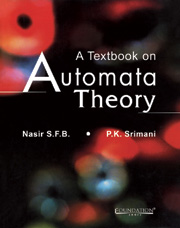Book contents
- Frontmatter
- Contents
- Preface
- Acknowledgements
- List of Abbreviations
- 1 Fundamentals of Automata
- 2 Formal Language Theory
- 3 Regular Expressions and Languages
- 4 Finite Automata
- 5 Equivalent Automata
- 6 Minimisation/Optimisation of DFA
- 7 Finite Automata and Regular Expressions
- 8 Transducers
- 9 Context-Free Grammars and Context-Free Languages
- 10 Simplification of Context-Free Grammar
- 11 Pushdown Automata
- 12 Pumping Lemma
- 13 Turing Machine
- 14 TM Extensions and Languages
- 15 Formal Languages/Grammar Hierarchy
- Appendix A Symbol Chart
- Appendix B Sets, Relations, Functions and Mathematical Induction
- Appendix C System Modelling
- Index
Appendix C - System Modelling
Published online by Cambridge University Press: 26 October 2011
- Frontmatter
- Contents
- Preface
- Acknowledgements
- List of Abbreviations
- 1 Fundamentals of Automata
- 2 Formal Language Theory
- 3 Regular Expressions and Languages
- 4 Finite Automata
- 5 Equivalent Automata
- 6 Minimisation/Optimisation of DFA
- 7 Finite Automata and Regular Expressions
- 8 Transducers
- 9 Context-Free Grammars and Context-Free Languages
- 10 Simplification of Context-Free Grammar
- 11 Pushdown Automata
- 12 Pumping Lemma
- 13 Turing Machine
- 14 TM Extensions and Languages
- 15 Formal Languages/Grammar Hierarchy
- Appendix A Symbol Chart
- Appendix B Sets, Relations, Functions and Mathematical Induction
- Appendix C System Modelling
- Index
Summary
Thermostat
Consider the problem of heating a room. Assume that the thermostat is used as a controller and we do not have the exact model of how the the thermostat functions. It is only known that the thermostat turns on the radiator when temperature is between 68 and 70 degrees and it turns off the radiator when temperature is between 80 and 82 degrees. This heating system can be modelled as an automaton shown in the figure below, where X denotes the temperature.
The automaton shown is a non deterministic automaton, in the sense that for a given initial condition it accepts the whole family of different executions (solutions).
Elevator Controller
Consider an elevator that serves two floors. Inputs to elevator are calls to a floor, either from inside the elevator or from the floor itself.
The following are the 3 possible inputs:
i) no calls (a)
ii) call to floor one (b)
iii) call to floor two. (c)
The following are the 6 possible states:
q1 – waiting on first floor
q2 – about to go up
q3 – going up
q4 – going down
q5 – waiting on second floor
q6 – about to go down.
The above transition diagram is without the accepting and rejecting states because the elevator design is simple and acceptance is not an issue. In designing a more complex elevator, with states like overloading, breakdown etc., accepting and rejecting states become significant.
- Type
- Chapter
- Information
- A Textbook on Automata Theory , pp. 597 - 600Publisher: Foundation BooksPrint publication year: 2007



